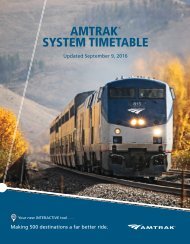Queens
northeast_queens_bus_study_-_final_9-28-15
northeast_queens_bus_study_-_final_9-28-15
You also want an ePaper? Increase the reach of your titles
YUMPU automatically turns print PDFs into web optimized ePapers that Google loves.
, Metropolitan Transportation Authority<br />
Service Coverage<br />
MTA operates an extensive bus network in Northeast <strong>Queens</strong> with thirty‐nine local, limited and<br />
express bus routes. The extent of transit coverage is determined by Service Guidelines adopted<br />
by the MTA Board.<br />
Guidelines<br />
The two most significant criteria in the service coverage guidelines are transit dependency and<br />
population density. Transit dependency, based on the percentage of households in an area<br />
without access to an automobile, displays an absolute need for accessible transit service.<br />
Population density, or the concentration of residents in a neighborhood, shows where service is<br />
most viable. MTA established the guidelines shown in Table 2 for local and limited bus route<br />
spacing:<br />
Table 2. Bus Service Guidelines<br />
Transit Dependency<br />
(Percentage Of Households<br />
W/O Automobiles)<br />
Over 15%<br />
15% And Under<br />
Population Density (Persons Per Square Mile)<br />
Greater Than 12,000<br />
2,000‐2,600 feet (3/8‐<br />
1/2 mile) between routes<br />
2,000‐2,600 feet (3/8‐<br />
1/2 mile) between routes<br />
12,000 Or Less<br />
2,000‐2,600 feet (3/8‐<br />
1/2 mile) between routes<br />
5,280 feet (1 mile) between<br />
routes<br />
Three percent of New York City Census block groups fall into the 1‐mile coverage category, with<br />
a population density less than 12,000 people per square mile and fifteen percent or less of<br />
households without a car. Average distance to a bus route is one‐half the distance between<br />
routes, or one‐half mile. The majority of Northeast <strong>Queens</strong> falls within the higher‐density<br />
category, one‐half mile between routes, based on transit dependency and population density.<br />
Average walking distance to a bus route is one‐half the distance between routes, or one‐quarter<br />
mile.<br />
Other criteria sometimes come into play when determining route spacing, including geographic<br />
factors (e.g., terrain, type of the existing street network) and demographic factors (e.g.,<br />
employment density, population within walking distance of a stop, significant concentrations of<br />
elderly and/or disabled persons, presence of major destinations such as hospitals, schools, or<br />
shopping).<br />
Coverage in Northeast <strong>Queens</strong><br />
In the study area, bus coverage of inhabited areas was analyzed based on the one‐half mile<br />
distance between bus routes – green and open spaces were not included in the analysis.<br />
Customers within the bus coverage area are within one‐quarter mile (10 minute walk) of a bus<br />
route. Bus coverage in the study area was analyzed in four scenarios:<br />
<br />
<br />
<br />
<br />
Local/Limited Weekday Coverage<br />
Local/Limited Weekend Coverage<br />
Local/Limited Overnight Coverage<br />
Express/Subway/LIRR Coverage<br />
12



